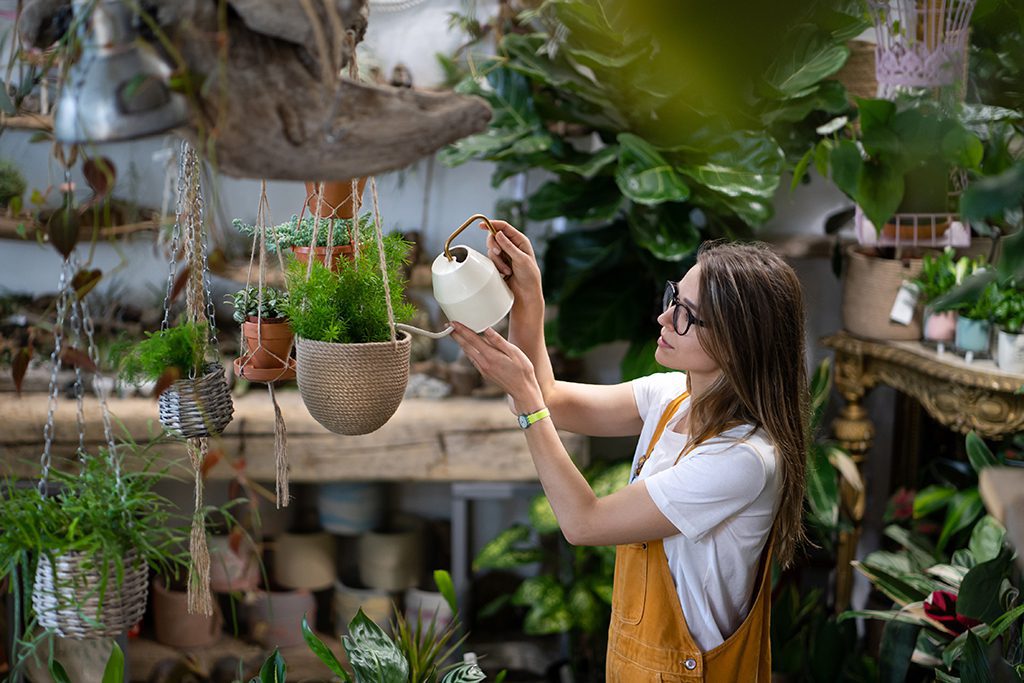
One of the ways a florist can compete with big box stores for houseplant sales is to offer niche or exotic plants, and offer customers opportunities to customize their purchases with pots and other accessories.
Houseplants fill shelves at all kinds of retail outlets, from supermarkets to home improvement stores and deep discount centers. Retail florists can get in on the action, too, and new findings about where shoppers go to buy plants — and why — can help florists develop merchandising and marketing strategies to grow sales.
The Consumer Houseplant Purchasing study — just released by the Floral Marketing Fund, managed by the American Floral Endowment — highlights emerging trends in the plant market, including who is buying houseplants where shoppers go to grab some greenery and why they shop where they do. The study was cosponsored by Altman Plants, Costa Farms, Green Circle Growers, Hortica and Metrolina Greenhouses.
Who’s Cornered the Market?
The study reveals that home improvement stores and independent garden centers are consumers’ top houseplant destinations, beating out independent florists, farmers’ markets, wholesale stores, supermarket florists, online sites, wire services, super-discount stores and others.
The secret behind home improvement stores’ ranking as a hotspot for houseplants? Location. “Home improvement stores are strategically located near other shopping,” says Hayk Khachatryan, Ph.D., of Mid-Florida Research and Education Center at the University of Florida, one of the researchers behind the study. “I believe that’s why they are the largest category for plant sales.”
Houseplant shoppers also base their buying decisions on quality, price, and selection, in that order, Khachatryan says. “For the entire market, I do believe that price is near the top priority, but it isn’t the most important aspect,” he says. “Quality is what more people are looking for. That’s definitely true for plant enthusiasts, Master Gardeners, gardeners over 50 years old and people who are educated,” Khachatryan says. “This is a tiny segment of the entire market, but for this segment, price may be the third or fourth thing that drives sales.”
Specialize and Customize
How can florists compete with a conveniently located home improvement store? By carrying quality houseplants and a good selection, which doesn’t have to be deep across all plant types.
For instance, develop your store’s reputation as a source for philodendron, cacti or succulents. Or perhaps corner the local market with plants for the home office. Some supermarket chains have targeted large floor plants. Choose a niche and use effective marketing to grow your plant sales.
Another one of the top factors influencing plant purchasing decisions is the ability to customize. Consumers like to customize their plants, whether it’s with a container, an in-pot trellis, or a plant stake with a unique topper. Florists excel at customization. Apply those skills to green plants to help earn loyal customers and drive sales.
E-Commerce Is Gaining Ground
The study also shows that online houseplant purchasing is growing. While the majority of the plant purchasers in the study haven’t bought plants online and prefer to purchase in-store, 37 percent of purchasers had bought houseplants online. Plant buyers also indicated that, on average, they planned to purchase 53 percent more houseplants online last year.
Researcher Charlie Hall, Ph.D., of Texas A & M University, credits the pandemic with the intense growth in the e-commerce of houseplants. “E-commerce of plants is not simply a fad,” Hall says. “ been a driving force of changing behavior in the industry and will continue to do so.”
The main benefit to buying online is the ease of ordering. Customers can shop many types of plants 24 hours a day and receive their order quickly. On the other hand, some consumers hesitate to buy houseplants online because of the potential for damage during shipping and because they can’t inspect the plant before making a purchase. For those reasons, many consumers indicated that they would rather shop locally for plants.
How to Woo Houseplant Customers
To make your shop the go-to spot for plant parents, capitalize on the reasons they’re buying plants.
- Service is No. 1. If you want to increase your customer base for houseplant sales, focus on customer service. Khachatryan believes that independent garden centers rate as a top venue for plant purchasers due to product selection and customer service. “Customer service is where independent shops can shine,” he says. Service can take the form of a barista-style planting bar, where clients transplant their purchases and select a cachepot. Or maybe offer intensive growing information and a troubleshooting “Plant Doctor” service.
- Promote variety. The study reveals that plant buyers prize selection — it’s one of the top three things they look for when buying plants. If your shop carries a wide houseplant selection, market that fact. Want to turn your shop into a plant destination? Work with vendors to obtain exclusive varieties. (Exclusivity was also among the top factors that consumers look for when choosing a retail outlet for plants.)
- Think décor. Incorporate houseplants throughout sales displays, especially in home décor areas. Many consumers are using plants as décor, and creative displays in the shop can inspire them with ideas of how to mix plants with the home accessories you sell.
- Try e-commerce. Plant shoppers are avid social media users. Capitalize on that by selling plants online. Turn web sales into foot traffic with container specials, customized soil mixes or a full-service potting bench.
Look to SAF for More Plant Insights
Want to get up to speed on plant care, sourcing and marketing? Check out the Society of American Florists’ Great Big Plant Event on-demand. Watch for more houseplant articles in SAF NOW that explore the study’s results in depth to help guide your houseplant sales and marketing strategies for 2022. To dig into the houseplant study’s results, check out the Floral Marketing Fund’s webinar.
Julie Martens Forney is a contributing writer for the Society of American Florists.

